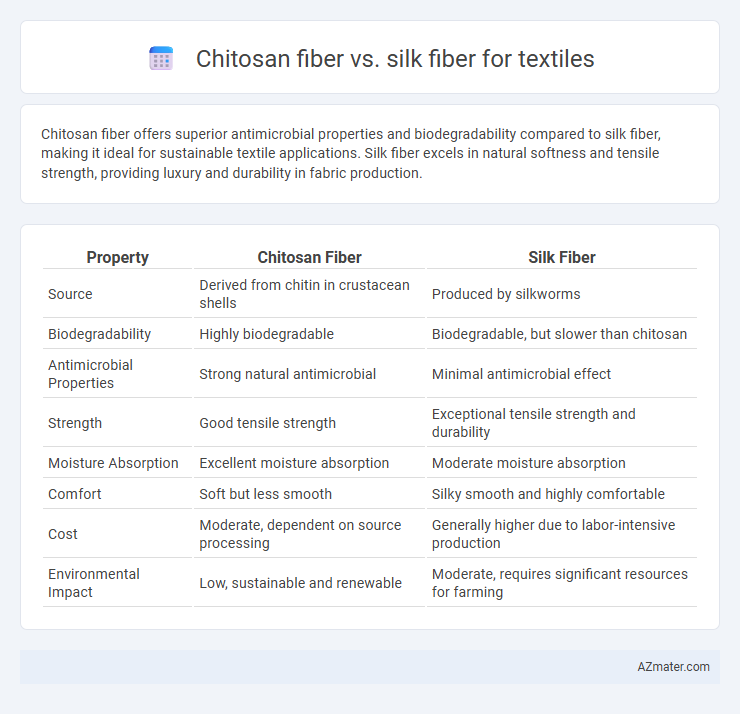Chitosan fiber offers superior antimicrobial properties and biodegradability compared to silk fiber, making it ideal for sustainable textile applications. Silk fiber excels in natural softness and tensile strength, providing luxury and durability in fabric production.
Table of Comparison
| Property | Chitosan Fiber | Silk Fiber |
|---|---|---|
| Source | Derived from chitin in crustacean shells | Produced by silkworms |
| Biodegradability | Highly biodegradable | Biodegradable, but slower than chitosan |
| Antimicrobial Properties | Strong natural antimicrobial | Minimal antimicrobial effect |
| Strength | Good tensile strength | Exceptional tensile strength and durability |
| Moisture Absorption | Excellent moisture absorption | Moderate moisture absorption |
| Comfort | Soft but less smooth | Silky smooth and highly comfortable |
| Cost | Moderate, dependent on source processing | Generally higher due to labor-intensive production |
| Environmental Impact | Low, sustainable and renewable | Moderate, requires significant resources for farming |
Overview of Chitosan and Silk Fibers
Chitosan fiber, derived from chitin found in crustacean shells, is biodegradable, antimicrobial, and exhibits excellent moisture absorption, making it ideal for functional textiles. Silk fiber, produced by silkworms, is prized for its natural sheen, softness, and strength, providing luxury and comfort in textile applications. Both fibers serve distinct market needs: chitosan for performance and health-focused textiles, and silk for high-end fashion and upholstery.
Source and Production Methods
Chitosan fiber is derived from chitin found in crustacean shells through a deacetylation process followed by spinning, offering a sustainable alternative sourced primarily from seafood industry waste. Silk fiber, produced by silkworms through natural protein secretion, undergoes harvesting and reeling to form continuous filaments used in textiles. Production of chitosan fiber emphasizes biopolymer extraction and chemical modification, whereas silk fiber production relies on sericulture and mechanical processing of cocoons.
Physical and Mechanical Properties
Chitosan fiber exhibits superior antimicrobial properties and enhanced moisture absorption compared to silk fiber, making it highly suitable for medical textiles and activewear. Its tensile strength is comparable to silk, but chitosan fiber demonstrates better biodegradability and environmental sustainability. Silk fiber, however, offers superior softness and natural luster, contributing to higher aesthetic value in luxury textile products.
Biocompatibility and Safety
Chitosan fiber exhibits superior biocompatibility compared to silk fiber due to its natural antimicrobial properties and ability to promote wound healing, making it highly suitable for medical textile applications. Silk fiber is biocompatible and widely used in sutures and luxury textiles but lacks inherent antimicrobial activity. Safety profiles favor chitosan fiber as it reduces the risk of allergic reactions and microbial growth, enhancing wearer comfort and hygiene in textile products.
Environmental Impact and Sustainability
Chitosan fiber, derived from natural chitin found in crustacean shells, offers a biodegradable and renewable alternative to traditional silk fiber, which relies on sericulture involving mulberry cultivation and silkworm farming. The production of chitosan fiber generates fewer greenhouse gas emissions and reduces waste by utilizing seafood industry byproducts, enhancing circular economy principles compared to the resource-intensive and water-heavy silk production process. Chitosan fiber's antimicrobial properties also contribute to longer-lasting textiles, minimizing environmental impact over the product lifecycle relative to the more delicate nature of silk fiber.
Dyeing and Finishing Techniques
Chitosan fiber exhibits exceptional dye affinity due to its abundant amino groups, enabling vibrant and uniform coloration with both natural and synthetic dyes. Silk fiber, renowned for its smooth protein structure, allows for delicate dye uptake, often requiring milder dyeing conditions to preserve luster and texture. Finishing techniques for chitosan fibers enhance antimicrobial properties and moisture management, while silk finishing emphasizes maintaining softness and sheen through processes like sericin removal and enzyme treatments.
Moisture Absorption and Breathability
Chitosan fiber exhibits superior moisture absorption compared to silk fiber due to its hydrophilic amino groups, enabling efficient sweat uptake and quick drying. Silk fiber, while naturally breathable, offers moderate moisture management but falls short of chitosan's antimicrobial properties that enhance skin comfort in humid conditions. The enhanced breathability of chitosan fiber supports better air circulation, making it ideal for activewear and medical textiles requiring moisture control and odor resistance.
Applications in Textile Industry
Chitosan fiber exhibits excellent antimicrobial properties and moisture absorption, making it ideal for medical textiles, sportswear, and hygiene products, whereas silk fiber is prized for its natural luster, softness, and strength, frequently used in luxury garments, upholstery, and high-end fashion. The biodegradability and biocompatibility of chitosan fiber enhance its use in eco-friendly and functional textiles, while silk fiber remains the preferred choice for premium textiles requiring durability and elegance. Innovations in blending chitosan with other fibers improve fabric performance, expanding applications in protective and health-oriented textile products.
Cost Comparison and Availability
Chitosan fiber, derived from chitin in crustacean shells, offers a cost-effective alternative to traditional silk fiber, with lower production expenses due to abundant raw materials and simpler processing methods. Silk fiber, produced by silkworms, tends to have higher costs attributed to labor-intensive cultivation and limited geographic availability. The widespread availability of chitosan fiber promotes scalability in textile manufacturing, while silk's limited supply restricts mass production and increases market price volatility.
Future Trends and Innovations
Chitosan fiber, derived from chitin in crustacean shells, offers antimicrobial properties and biodegradability that position it as a sustainable alternative to conventional silk fiber in textile applications. Innovations in blending chitosan with silk aim to enhance fabric strength, moisture management, and skin-friendly characteristics, meeting growing consumer demand for eco-friendly and functional textiles. Future trends emphasize scalable production methods for chitosan fiber and smart textile integration, including bioactive coatings and wearable health monitoring features.

Infographic: Chitosan fiber vs Silk fiber for Textile
 azmater.com
azmater.com